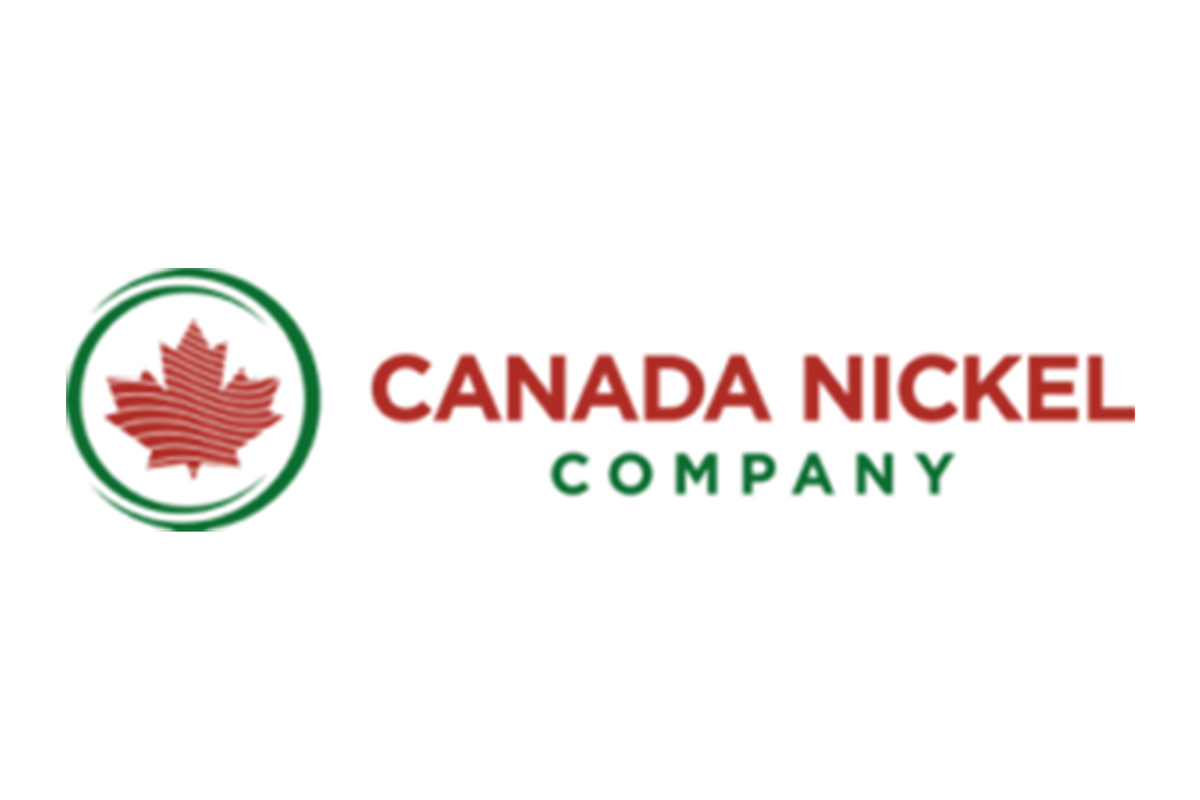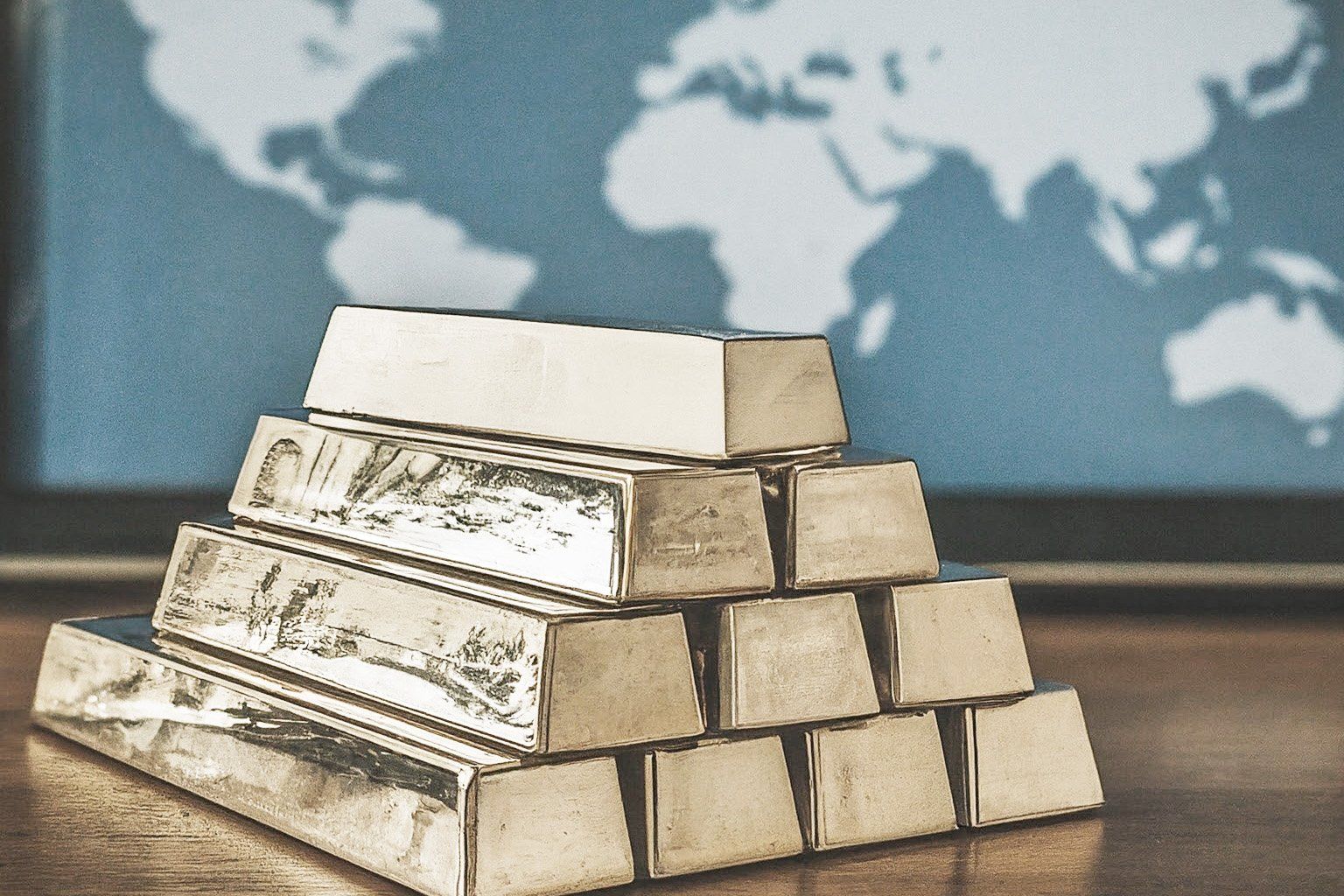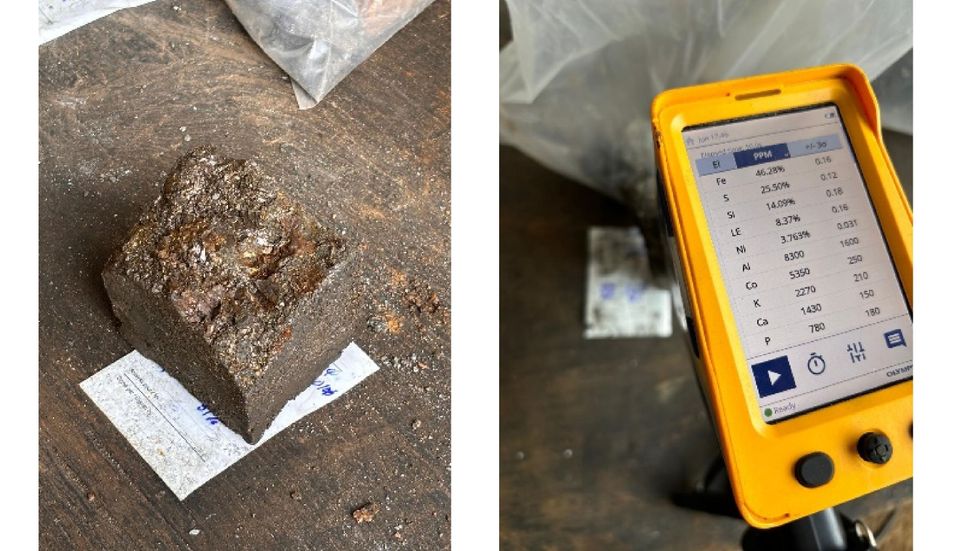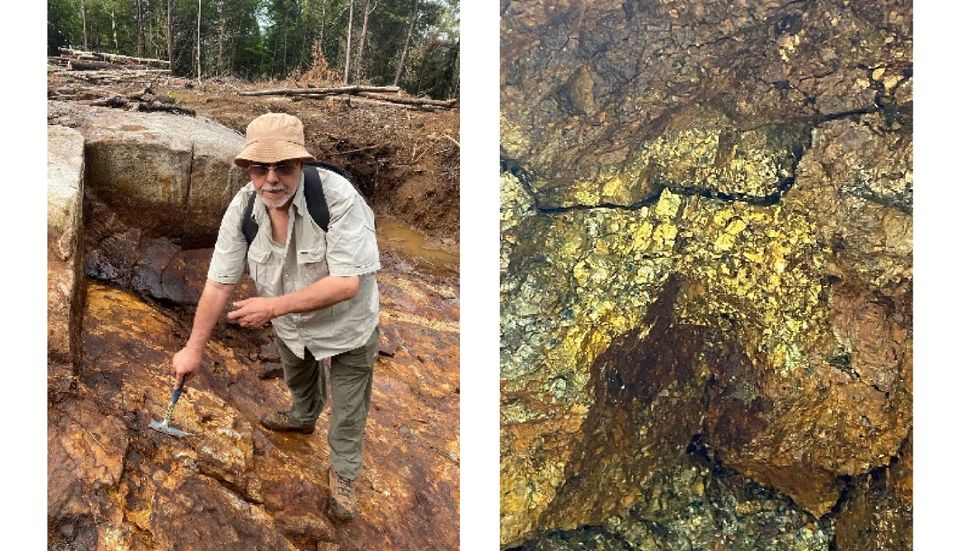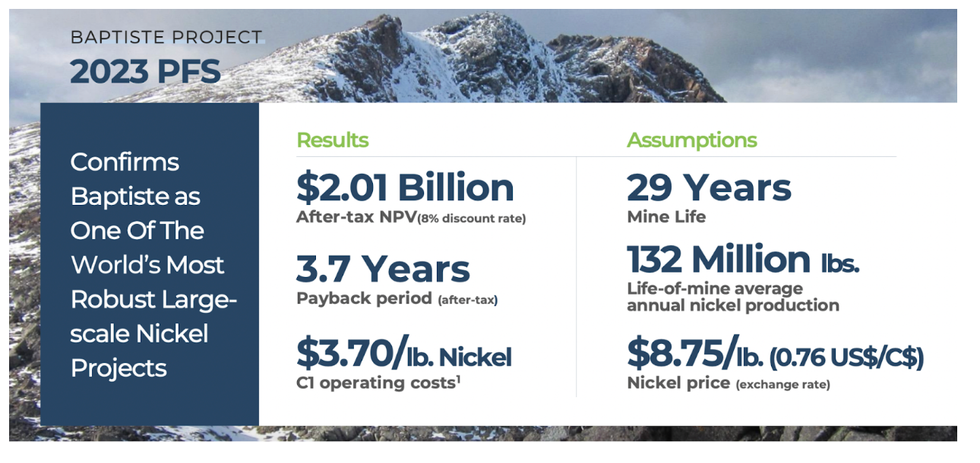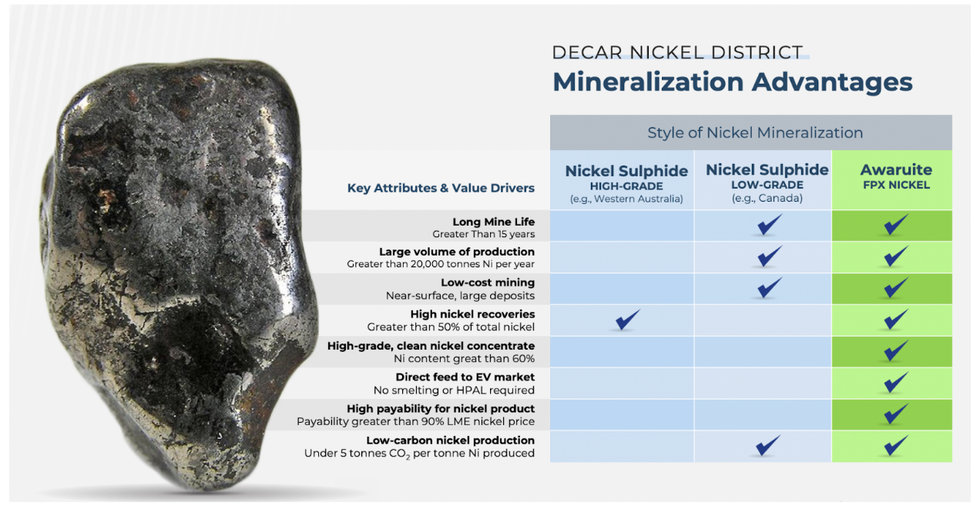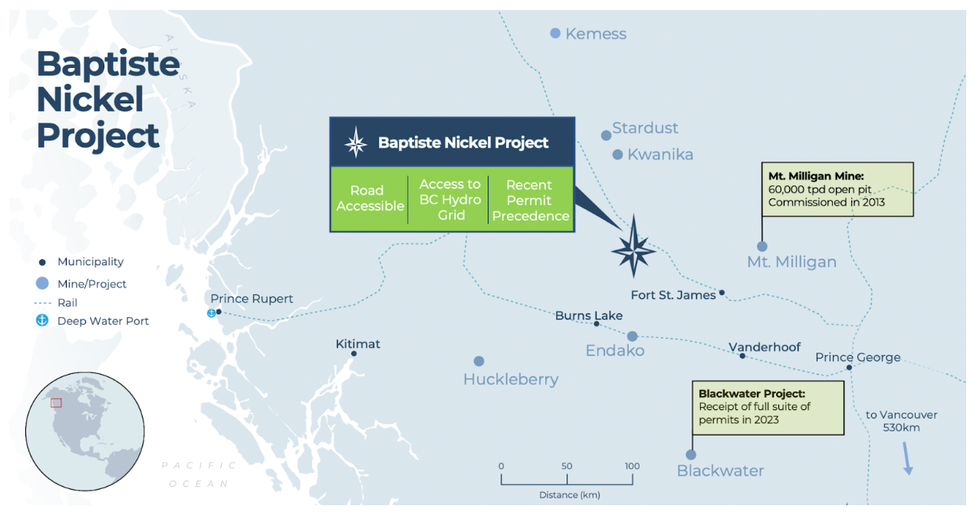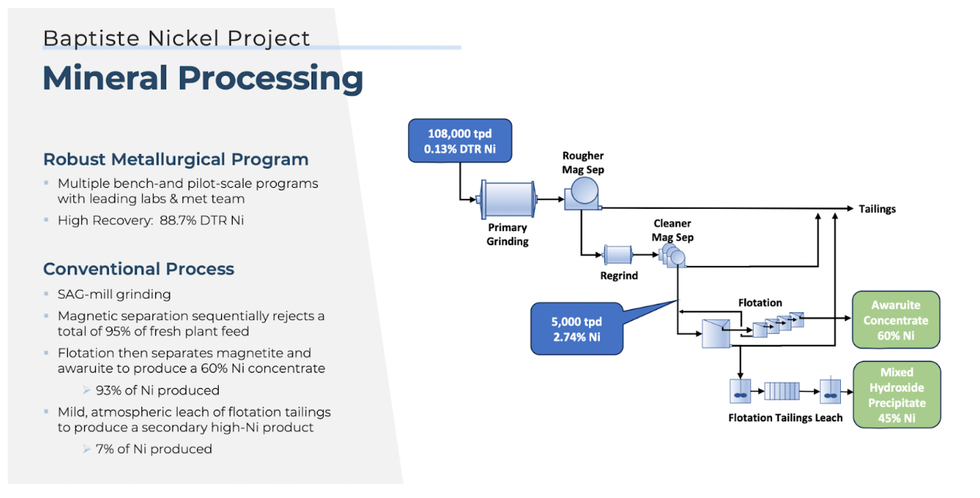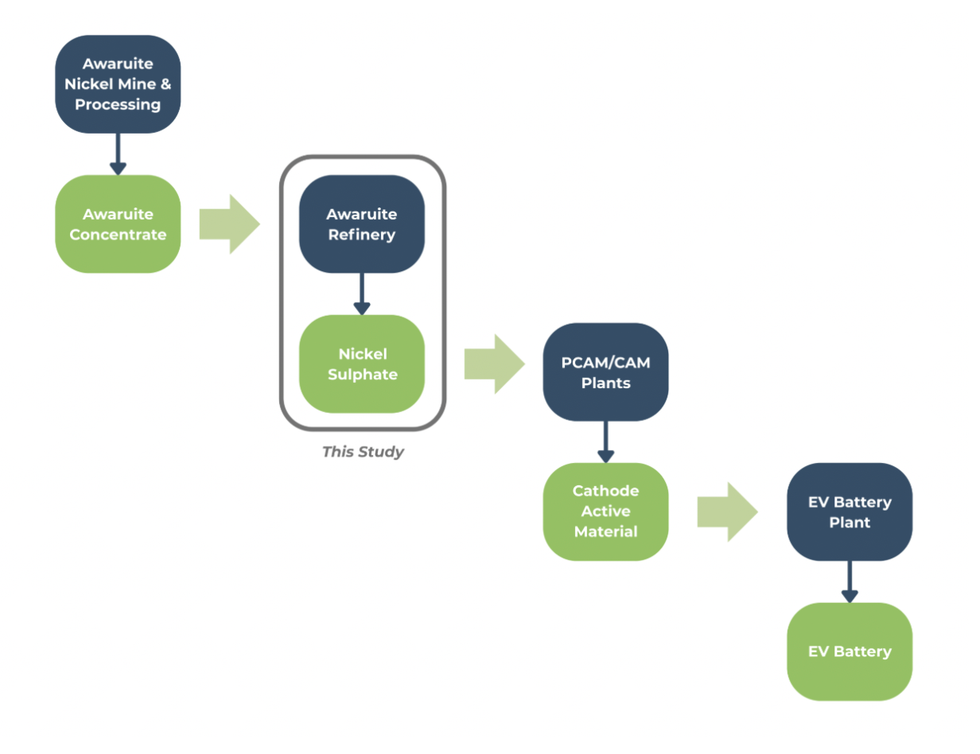Horizonte Minerals Plc, (AIM: HZM, TSX: HZM) (‘Horizonte' or ‘the Company') a nickel company focused on Brazil, announces that in connection with its previously announced offering of $9.2 million of special warrants to be qualified by short form prospectus of the Company to be filed as soon as practicable after closing, the Company engaged its auditors to perform a review of its unaudited financial results for the three and nine month periods to 30 September 2020 (the "Previously Filed Interim Financial Statements").
As part of the review, certain adjustments were made to the Previously Filed Interim Financial Statements and the management discussion and analysis for the same period (the "Previously Filed Interim MD&A"). The key adjustment is the result of a new accounting policy adopted regarding the capitalisation of borrowing costs due to the interest charge on the royalty financing arrangement between the Company and Orion Mine Finance.
None of the adjustments have a cash impact and the net result is a £2.3 million reduction in losses and subsequent £2.3 million increase in net assets. To reflect the adjustments, the Company has today published amended unaudited financial results for the three and nine month periods to 30 September 2020 (the "Amended Interim Financial Statements") and the Management Discussion and Analysis for the same period (the "Amended Interim MD&A"). Both the Amended Interim Financial Statements and the Amended Interim MD&A have been posted on the Company's website at www.horizonteminerals.com and are also available on the Company's profile at SEDAR at www.sedar.com.
For further information, visit www.horizonteminerals.com or contact:
| Horizonte Minerals plc Jeremy Martin (CEO) Anna Legge (Corporate Communications) | info@horizonteminerals.com +44 (0) 203 356 2901 |
| Peel Hunt (NOMAD & Joint Broker) Ross Allister David McKeown | +44 (0)20 7418 8900 |
| BMO (Joint Broker) Thomas Rider Pascal Lussier Duquette Andrew Cameron | +44 (0) 20 7236 1010 |
About Horizonte Minerals:
Horizonte Minerals plc is an AIM and TSX-listed nickel development company focused in Brazil. The Company is developing the Araguaia project, as the next major ferronickel mine in Brazil, and the Vermelho nickel-cobalt project, with the aim of being able to supply nickel and cobalt to the EV battery market. Both projects are 100% owned.
Horizonte Minerals plc
Unaudited Amended Condensed Consolidated Interim Financial Statements for the nine months ended 30 September 2020
Amended Condensed Consolidated Statement of Comprehensive Income
| 9 months ended 30 September | 3 months ended 30 September | ||||||||
| 2020 | 2019 | 2020 | 2019 | ||||||
| Unaudited Amended (note 2) | Unaudited | Unaudited Amended (note 2) | Unaudited | ||||||
| Notes | £ | £ | £ | £ | |||||
| Administrative expenses | (2,342,987 | ) | (1,910,913 | ) | (777,847 | ) | (941,996 | ) | |
| Charge for share options granted | - | (290,833 | ) | - | (53,662 | ) | |||
| Change in value of contingent consideration | (41,583 | ) | 145,561 | 163,209 | (46,640 | ) | |||
| Change in fair value of derivative | 10 b | (433,522 | ) | - | (433,522 | ) | - | ||
| Gain/(Loss) on foreign exchange | 410,804 | (21,706 | ) | (716,015 | ) | (17,657 | ) | ||
| Loss from operations | (2,407,288 | ) | (2,077,891 | ) | (1,764,175 | ) | (1,059,955 | ) | |
| Finance income | - | 50,085 | - | 16,294 | |||||
| Finance costs | 6 | (178,280 | ) | (222,788 | ) | (67,337 | ) | (75,951 | ) |
| Loss before taxation | (2,585,568 | ) | (2,250,594 | ) | (1,831,512 | ) | ( 1,119,612 | ) | |
| Taxation | (51,071 | ) | - | (51,071 | ) | - | |||
| Loss for the year from continuing operations | ( 2,636,639 | ) | (2,250,594 | ) | (1,882,583 | ) | (1,119,612 | ) | |
| Other comprehensive income Items that may be reclassified subsequently to profit or loss | |||||||||
| Currency translation differences on translating foreign operations | (9,232,975 | ) | (1,093,862 | ) | (1,165,298 | ) | (1,559,385 | ) | |
| Other comprehensive income for the period, net of tax | ( 9,232,975 | ) | (1,093,862 | ) | ( 1,165,298 | ) | (1,559,385 | ) | |
| Total comprehensive income for the period attributable to equity holders of the Company | (11,869,614 | ) | (3,344,456 | ) | (3,047,881 | ) | (2,678,997 | ) | |
| Earnings per share from continuing operations attributable to the equity holders of the Company | |||||||||
| Basic & Diluted earnings per share (pence per share) | 12 | (0.182 | ) | (0.157 | ) | (0.130 | ) | (0.078 | ) |
Unaudited Amended Condensed Consolidated Statement of Financial Position
| 30 September 2020 | 31 December 2019 | ||||
| Unaudited Amended (note 2) | Unaudited | ||||
| Notes | £ | £ | |||
| Assets | |||||
| Non-current assets | |||||
| Intangible assets | 7 | 6,347,659 | 7,057,445 | ||
| Property, plant & equipment | 8 | 28,894,718 | 32,260,544 | ||
| 35,242,377 | 39,317,989 | ||||
| Current assets | |||||
| Trade and other receivables | 84,703 | 134,726 | |||
| Derivative financial asset | 10 b | 1,873,434 | 2,246,809 | ||
| Cash and cash equivalents | 13,584,055 | 17,760,330 | |||
| 15,542,192 | 20,141,865 | ||||
| Total assets | 50,784,569 | 59,459,854 | |||
| Equity and liabilities | |||||
| Equity attributable to owners of the parent | |||||
| Issued capital | 11 | 14,493,773 | 14,463,773 | ||
| Share premium | 11 | 41,848,306 | 41,785,306 | ||
| Other reserves | (13,899,905 | ) | (4,666,930 | ) | |
| Accumulated losses | (22,471,731 | ) | (19,835,092 | ) | |
| Total equity | 19,970,443 | 31,747,057 | |||
| Liabilities | |||||
| Non-current liabilities | |||||
| Contingent consideration | 6,508,174 | 6,246,071 | |||
| Royalty Finance | 23,489,407 | 20,570,411 | |||
| Deferred tax liabilities | 155,692 | 212,382 | |||
| 30,153,273 | 27,028,864 | ||||
| Current liabilities | |||||
| Trade and other payables | 660,853 | 683,933 | |||
| Deferred consideration | - | - | |||
| 660,853 | 21,254,344 | ||||
| Total liabilities | 30,814,126 | 27,712,797 | |||
| Total equity and liabilities | 50,784,569 | 59,459,854 | |||
Unaudited Amended Condensed statement of changes in shareholders' equity
| Attributable to the owners of the parent | ||||||||
| Share capital £ | Share premium £ | Accumulated losses £ | Other reserves £ | Total £ | ||||
| As at 1 January 2019 | 14,325,218 | 41,664,018 | (16,990,291 | ) | (2,039,991 | ) | 36,958,954 | |
| Comprehensive income | ||||||||
| Loss for the period | - | - | (2,250,594 | ) | - | (2,250,594 | ) | |
| Other comprehensive income | ||||||||
| Currency translation differences | - | - | - | (1,093,862 | ) | (1,093,862 | ) | |
| Total comprehensive income | - | - | (2,250,594 | ) | (1,093,862 | ) | (3,344,456 | ) |
| Transactions with owners | ||||||||
| Issue of ordinary shares | 138,555 | 121,288 | - | - | 259,843 | |||
| Issue costs | - | - | - | - | - | |||
| Share based payments | - | - | 290,833 | - | 290,833 | |||
| Total transactions with owners | 138,555 | 121,288 | 290,833 | - | 550,676 | |||
| As at 30 September 2019 (unaudited) | 14,463,773 | 41,785,306 | (18,950,052 | ) | (3,133,853 | ) | 34,165,174 | |
| Attributable to the owners of the parent | ||||||||
| Share capital £ | Share premium £ | Accumulated losses £ | Other reserves £ | Total £ | ||||
| As at 1 January 2020 | 14,463,773 | 41,785,306 | (19,835,092 | ) | (4,666,930 | ) | 31,747,057 | |
| Comprehensive income | ||||||||
| Loss for the period | - | - | (2,636,639 | ) | - | (2,636,639 | ) | |
| Other comprehensive income | ||||||||
| Currency translation differences | - | - | - | (9,232,975 | ) | (9,232,975 | ) | |
| Total comprehensive income | - | - | (2,636,639 | ) | (9,232,975 | ) | (11,313,185 | ) |
| Transactions with owners | ||||||||
| Issue of ordinary shares | 30,000 | 63,000 | - | - | 93,000 | |||
| Issue costs | - | - | - | - | - | |||
| Share based payments | - | - | - | - | - | |||
| Total transactions with owners | 30,000 | 63,000 | - | - | 93,000 | |||
| As at 30 September 2020 (unaudited) Amended (note2) | 14,493,773 | 41,848,306 | (22,471,731 | ) | (13,899,905 | ) | 19,970,443 | |
Amended Condensed Consolidated Statement of Cash Flows
| 9 months ended 30 September | 3 months ended 30 September | ||||||||
| 2020 | 2019 | 2020 | 2019 | ||||||
| Unaudited Amended (note2) | Unaudited | Unaudited Amended (note2) | Unaudited | ||||||
| £ | £ | £ | £ | ||||||
| Cash flows from operating activities | |||||||||
| Loss before taxation | (2,585,568 | ) | (2,250,594 | ) | (1,831,512 | ) | (1,119,612 | ) | |
| Interest income | (122,907 | ) | (50,085 | ) | (32,177 | ) | (16,294 | ) | |
| Finance costs | 178,280 | 222,788 | 67,337 | 75,951 | |||||
| Exchange differences | (338,547 | ) | 21,706 | 697,121 | 17,657 | ||||
| Employee share options charge | - | 290,833 | - | 53,662 | |||||
| Change in fair value of contingent consideration | 41,538 | (145,561 | ) | (163,209 | ) | 46,640 | |||
| Fair value of Derivative asset | 433,522 | - | 433,522 | - | |||||
| Depreciation | - | - | - | - | |||||
| Operating loss before changes in working capital | (2,393,682 | ) | (1,910,913 | ) | (828,918 | ) | (941,996 | ) | |
| Decrease/(increase) in trade and other receivables | 50,742 | (45,771 | ) | (2,384 | ) | (42,496 | ) | ||
| (Decrease)/increase in trade and other payables | (23,080 | ) | 468,782 | 290,166 | 442,376 | ||||
| Net cash outflow from operating activities | (2,336,020 | ) | (1,487,902 | ) | (541,136 | ) | (542,116 | ) | |
| Cash flows from investing activities | |||||||||
| Purchase of intangible assets | - | (1,944,388 | ) | - | (655,180 | ) | |||
| Purchase of property, plant and equipment | (2,436,966 | ) | - | (878,685 | ) | - | |||
| Interest received | 122,907 | 50,085 | 32,177 | 16,294 | |||||
| Net cash used in investing activities | (2,314,059 | ) | (1,894,303 | ) | (846,508 | ) | (638,886 | ) | |
| Cash flows from financing activities | |||||||||
| Proceeds form issue of ordinary shares | 93,000 | - | 93,000 | - | |||||
| Issue costs | - | - | - | - | |||||
| Net cash used in financing activities | 93,000 | - | 93,000 | - | |||||
| Net decrease in cash and cash equivalents | (4,587,079 | ) | (3,382,205 | ) | (1,294,644 | ) | (1,181,002 | ) | |
| Cash and cash equivalents at beginning of period | 17,760,330 | 6,527,115 | 15,594,717 | 4,322,699 | |||||
| Exchange gain/(loss) on cash and cash equivalents | 410,804 | (20,870 | ) | (716,018 | ) | (17,657 | ) | ||
| Cash and cash equivalents at end of the period | 13,584,055 | 3,124,040 | 13,584,055 | 3,124,040 | |||||
Notes to the Financial Statements
1. General information
The principal activity of the Company and its subsidiaries (together ‘the Group') is the exploration and development of precious and base metals. There is no seasonality or cyclicality of the Group's operations.
The Company's shares are listed on the Alternative Investment Market of the London Stock Exchange (AIM) and on the Toronto Stock Exchange (TSX). The Company is incorporated and domiciled in the United Kingdom. The address of its registered office is Rex House, 4-12 Regent Street, London SW1Y 4RG.
2. Basis of preparation
The condensed consolidated interim financial statements have been prepared using accounting policies consistent with International Financial Reporting Standards and in accordance with International Accounting Standard 34 Interim Financial Reporting . The condensed interim financial statements do not include all disclosures that would otherwise be required in a complete set of financial statements and should be read in conjunction with the annual financial statements for the year ended 31 December 2019, which have been prepared in accordance with International Financial Reporting Standards (IFRS).
The condensed consolidated interim financial statements set out above do not constitute statutory accounts within the meaning of section 434 (3) of the Companies Act 2006. Statutory financial statements for the year ended 31 December 2019 were approved by the Board of Directors on 7 April 2020 and delivered to the Registrar of Companies. The report of the auditors on those financial statements was unqualified, did not draw attention to any matters by way of emphasis and did not contain a statement under sections 498(2) or 498(3) of the Companies Act 2006.
Amendment to current period figures
These financial statements have been restated to include certain amendments to the figures for both the 9 months and 3 months to 30 September 2020. The amendments are driven by the revision to the carrying value of the Orion Royalty finance arrangement, embedded derivative asset and contingent consideration to reflect up to date assumptions as well as the adoption of a new accounting policy at the beginning of 2020 in respect of the capitalisation of borrowing costs (refer to note 3). In addition, certain costs have been capitalised to the Mine Development Asset that had previously been capitalised to intangible assets. None of these adjustments have a cash impact on the balance sheet.
The effect of these amendments on the statement of financial position and statement of comprehensive are set out in the table below:
| Derivative asset | Royalty finance | Contingent consideration | Mine development asset | Trade Creditors | Intangible assets | Accumulated losses | ||||||||
| £ | £ | £ | £ | £ | £ | £ | ||||||||
| 30 September 2020 - as previously stated | 2,306,955 | (23,594,661 ) | (6,666,016 ) | 24,924,599 | (1,026,966 ) | 8,241,277 | (24,743,918 ) | |||||||
| Transfer of capitalised costs from intangibles assets to Mine development asset | - | - | - | 1,893,618 | - | (1,893,618) | - | |||||||
| Revision to carrying value of derivative financial asset | (433,522) | - | - | - | - | - | (433,522) | |||||||
| Revision to carrying value of Royalty finance & capitalisation | - | 105,254 | - | - | - | - | 105,254 | |||||||
| Revision to carrying value of Contingent consideration & capitalisation | - | - | 157,842 | - | - | - | 157,842 | |||||||
| Capitalisation of borrowing costs | - | - | - | 2,442,614 | - | - | 2,442,614 | |||||||
| Derecognition of accruals | - | - | - | (366,113) | 366,113 | - | - | |||||||
| 30 September 2020 - Amended | 1,873,433 | (23,489,407 ) | (6,508,174 ) | 28,894,718 | (660,853 ) | 6,347,659 | (22,471,731 ) | |||||||
| as previously stated 30/9/20 | Revision to carrying value of derivative financial asset | Revision to carrying value of Royalty finance | Revision to carrying value of Contingent consideration | Capitalisation of borrowing costs | Amended as at 30/9/20 | |||||
| £ | £ | £ | £ | £ | £ | |||||
| Statement of comprehensive income | ||||||||||
| Administrative expenses | (2,342,987) | - | - | - | - | (2,342,987) | ||||
| Charge for share options granted | - | - | - | - | - | - | ||||
| Change in value of contingent consideration | (79,425) | - | - | 157,841 | (119,999) | (41,584) | ||||
| Change in fair value of derivative | - | (433,522) | - | - | - | (433,522) | ||||
| Gain/(Loss) on foreign exchange | 410,804 | - | - | - | - | 410,804 | ||||
| Loss from operations | (2,011,610 ) | (433,522 ) | 0 | 157,841 | (119,999 ) | (2,407,288 ) | ||||
| Finance income | 122,907 | - | - | - | (122,907) | - | ||||
| Finance costs | (2,969,053) | - | 105,254 | - | 2,685,519 | (178,280) | ||||
| Loss before taxation | (4,857,756 ) | (433,522 ) | 105,254 | 157,841 | 2,442,614 | (2,585,568 ) | ||||
| Taxation | (51,071) | - | - | - | - | (51,071) | ||||
| Loss for the year from continuing operations | (4,908,827 ) | (433,522 ) | 105,254 | 157,841 | 2,442,614 | (2,636,639 ) | ||||
Going concern
The condensed consolidated interim financial statements have been prepared on a going concern basis. Although the Group's assets are not generating revenues and an operating loss has been reported, the Directors consider that the Group has sufficient funds to undertake its operating activities for a period of at least the next 12 months including any additional expenditure required in relation to its current exploration projects. In February 2021 the Group raised £18.8m by way of a placing of ordinary shares for a total of approx. £12.2m and a concurrent £6.6m Canadian offering. As at the date of these financial statements the placing had closed but the Canadian offering remained conditional. With this new placing money of £12.2m the Group has cash reserves which are considered sufficient by the Directors to fund the Group's committed expenditure both operationally and on its exploration project for the foreseeable future. However, as additional projects are identified and the Araguaia project moves towards production, additional funding will be required.
The uncertainty as to the future impact of the Covid-19 pandemic has been considered as part of the Group's adoption of the going concern basis. In response to government instructions the Group's offices in London and Brazil have been closed with staff working from home, international travel has stopped and all site work for the two projects has been restricted to a minimum level. However, a number of the key project milestones are still advancing and are currently on track being run by the teams in a virtual capacity.
Whilst the board considers that the effect of Covid-19 on the Group's financial results at this time is constrained to inefficiencies due to remote working, restrictions on travel and some minor potential delays to consultants work streams, the Board considers the pandemic could delay the Araguaia project financing timeline by a number of months (this will be dependent on the duration of the effects of the Covid-19 virus across global markets). However, the additional funding described above provides sufficient financing to enable the Company to continue its operations for at least 12 months should any additional cost arise as a result of any potential deterioration in the global Covid-19 situation.
As a result of considerations noted above, the Directors have a reasonable expectation that the Group has adequate resources to continue in operational existence for the foreseeable future. Thus, they continue to adopt the going concern basis of accounting in preparing these Financial Statements.
Risks and uncertainties
The Board continuously assesses and monitors the key risks of the business. The key risks that could affect the Group's medium term performance and the factors that mitigate those risks have not substantially changed from those set out in the Group's 2019 Annual Report and Financial Statements, a copy of which is available on the Group's website: www.horizonteminerals.com and on Sedar: www.sedar.com The key financial risks are liquidity risk, foreign exchange risk, credit risk, price risk and interest rate risk.
Use of estimates and judgements
The preparation of condensed consolidated interim financial statements requires management to make estimates and judgements that affect the reported amounts of assets and liabilities and disclosure of contingent assets and liabilities at the end of the reporting period. Significant items subject to such estimates are set out in note 4 of the Group's 2019 Annual Report and Financial Statements. The nature and amounts of such estimates and judgements have not changed significantly during the interim period.
Assessment of the impact of COVID-19
During the period of these financial statements there has been an ongoing significant global pandemic which has had significant knock on effects for the majority of the world's population, by way of the measures governments are taking to tackle the issue. This represents a risk to the Group's operations by restricting travel, the potential to detriment the health and wellbeing of its employees, as well as the effects that this might have on the ability of the Group to finance and advance its operations in the timeframes envisaged. The Group has taken steps to try and ensure the safety of its employees and operate under the current circumstances and feels the outlook for its operations remains positive, however risk remain should the pandemic worsen or changes its impact on the Group. The assessment of the possible impact on the going concern position of the Group is set out in the going concern note above. In addition, because of the long term nature of the Group's nickel projects and their strong project economics management do not consider that COVID has given rise to any impairment indicators. The Group has not received any government assistance.
3 . Significant accounting policies
Other than in respect of the capitalisation of borrowing costs the same accounting policies, presentation and methods of computation have been followed in these condensed consolidated interim financial statements as were applied in the preparation of the Group's audited Financial Statements for the year ended 31 December 2019
Capitalisation of borrowing costs
Borrowing costs are expensed except where they relates to the financing of construction or development of qualifying assets. Borrowing costs directly related to financing of qualifying assets in the course of construction are capitalised to the carrying value of the Araguaia mine development property. Where funds have been borrowed specifically to the finance the Project, the amount capitalised represents the actual borrowing costs incurred net of all interest income earned on the temporary re-investment of these borrowings prior to utilisation. Borrowing costs capitalised include:
- Interest charge on royalty finance
- Adjustments to the carrying value of the royalty finance
- Unwinding of discount on contingent consideration payable for Araguaia
All other borrowing costs are recognized as part of interest expense in the year which they are incurred.
Impact of accounting standards to be applied in future periods
There are a number of standards and interpretations which have been issued by the International Accounting Standards Board that are effective for periods beginning subsequent to 31 December 2020 (the date on which the company's next annual financial statements will be prepared up to) that the Group has decided not to adopt early. The Group does not believe these standards and interpretations will have a material impact on the financial statements once adopted.
4 Segmental reporting
The Group operates principally in the UK and Brazil, with operations managed on a project by project basis within each geographical area. Activities in the UK are mainly administrative in nature whilst the activities in Brazil relate to exploration and evaluation work. The newly established subsidiary responsible for the project finance for the Araguaia Project is domiciled in the Netherlands. The operations of this entity are reported separately and so it is recognised as a new segment. The reports used by the chief operating decision-maker are based on these geographical segments.
| 2020 | UK | Brazil | Netherlands | Total | ||||
| 9 months ended 30 September 2020 £ | 9 months ended 30 September 2020 £ | 9 months ended 30 September 2020 £ | 9 months ended 30 September 2020 £ | |||||
| Intragroup sales | 164,958 | (164,958 | ) | - | - | |||
| Administrative expenses | (1,636,689 | ) | (407,779 | ) | (298,521 | ) | (2,342,989 | ) |
| Loss on foreign exchange | 731,429 | (338,984 | ) | 18,359 | 410,804 | |||
| (Loss) from operations per reportable segment | (740,302 | ) | (911,721 | ) | (280,162 | ) | (1,932,185 | ) |
| Depreciation charges | - | - | - | - | ||||
| Additions to non-current assets | - | 2,436,966 | - | 2,436,966 | ||||
| Capitalisation of interest | - | 2,442,614 | - | 2,442,614 | ||||
| Foreign exchange movements to non-current assets | - | (8,245,405 | ) | - | (8,245,405 | ) | ||
| Reportable segment assets | 7,303,457 | 38,384,276 | 5,096,835 | 50,784,569 | ||||
| Reportable segment liabilities | 6,918,614 | 397,018 | 23,498,444 | 30,814,126 | ||||
| 2019 | UK | Brazil | Netherlands | Total | ||||
| 9 months ended 30 September 2019 £ | 9 months ended 30 September 2019 £ | 9 months ended 30 September 2019 £ | 9 months ended 30 September 2019 £ | |||||
| Intragroup sales | 128,784 | (128,784 | ) | - | - | |||
| Administrative expenses | (1,433,182 | ) | (477,731 | ) | - | (1,910,913 | ) | |
| Loss on foreign exchange | (6,655 | ) | (15,051 | ) | - | (21,706 | ) | |
| (Loss) from operations per reportable segment | (1,311,053 | ) | (621,566 | ) | - | (1,932,619 | ) | |
| Depreciation charges | - | - | - | - | ||||
| Additions and foreign exchange movements to non-current assets | - | 774,255 | - | 774,255 | ||||
| Reportable segment assets | 2,767,328 | 36,932,142 | - | 39,699,470 | ||||
| Reportable segment liabilities | 5,172,502 | 361,794 | - | 5,534,296 | ||||
| 2020 | UK | Brazil | Netherlands | Total | ||||
| 3 months ended 30 September 2020 | 3 months ended 30 September 2020 | 3 months ended 30 September 2020 | 3 months ended 30 September 2020 | |||||
| £ | £ | £ | £ | |||||
| Intragroup sales | 54,986 | (54,986 | ) | - | - | |||
| Administrative expenses | (554,880 | ) | (213,928 | ) | (9,037 | ) | (777,847 | ) |
| Loss on foreign exchange | (334,566 | ) | (374,326 | ) | (7,126 | ) | (716,018 | ) |
| (Loss) from operations per reportable segment | (834,460 | ) | (643,240 | ) | (16,163 | ) | (1,493,865 | ) |
| Depreciation charges | - | - | - | - | ||||
| Additions to non-current assets | - | 833,400 | - | 833,400 | ||||
| Capitalisation of interest | - | 687,260 | - | 687,260 | ||||
| Foreign exchange movements to non-current assets | - | (617,092 | ) | - | (617,092 | ) | ||
| 2019 | UK | Brazil | Netherlands | Total | ||||
| 3 months ended 30 September 2019 | 3 months ended 30 September 2019 | 3 months ended 30 September 2019 | 3 months ended 30 September 2019 | |||||
| £ | £ | £ | £ | |||||
| Revenue | - | - | - | - | ||||
| Administrative expenses | (794,076 | ) | (147,920 | ) | - | (941,996 | ) | |
| Profit/(Loss) on foreign exchange | 5,689 | (23,346 | ) | - | (17,657 | ) | ||
| (Loss) from operations per reportable segment | (788,387 | ) | (171,266 | ) | - | (959,653 | ) | |
| Inter segment revenues | - | - | - | - | ||||
| Depreciation charges | - | - | - | - | ||||
| Additions and foreign exchange movements to non-current assets | - | (969,007 | ) | - | (969,007 | ) | ||
A reconciliation of adjusted loss from operations per reportable segment to loss before tax is provided as follows:
| 9 months ended 30 September 2020 | 9 months ended 30 September 2019 | 3 months ended 30 September 2020 | 3 months ended 30 September 2019 | |||||
| £ | £ | £ | £ | |||||
| Loss from operations per reportable segment | (1,932,185 | ) | (1,932,619 | ) | (1,493,865 | ) | (959,653 | ) |
| – Change in fair value of contingent consideration | (41,583 | ) | 145,561 | 163,212 | (46,640 | ) | ||
| – Charge for share options granted | - | (290,833 | ) | - | (53,662 | ) | ||
| – Fair value of derivative asset | (433,522 | ) | - | (433,522 | ) | |||
| – Finance income | - | 50,085 | - | 16,294 | ||||
| – Finance costs | (178,280 | ) | (222,788 | ) | (67,337 | ) | (75,951 | ) |
| Loss before tax | (2,585,568 | ) | (2,250,594 | ) | (1,831,512 | ) | (1,119,612 | ) |
5 Change in Fair Value of Contingent Consideration
Contingent Consideration payable to Xstrata Brasil Mineração Ltda.
The contingent consideration payable to Xstrata Brasil Mineração Ltda has a carrying value of £3,018,176 at 30 September 2020 (31 December 2019: £2,975,935). It comprises US$5,000,000 consideration in cash as at the date of first commercial production from any of the resource areas within the Enlarged Project area. The key assumptions underlying the treatment of the contingent consideration the US$5,000,000 and a discount factor of 7.0% along with the estimated date of first commercial production.
As at 30 September 2020, there was a finance expense of £nil (2019: £222,788) recognised in finance costs within the Statement of Comprehensive Income in respect of this contingent consideration arrangement, as the discount applied to the contingent consideration at the date of acquisition was unwound. During 2020 the project entered the development phase and as a result borrowing costs including the unwinding of discount on deferred consideration for qualifying assets has been capitalised to the mine development asset during the first 9 months of the year £200,083 was capitalised.
The change in the fair value of contingent consideration payable to Xstrata Brasil Mineração Ltda generated a loss of £37,842 for the nine months ended 30 September 2020 (30 September 2019: £145,561 debit) due to changes in the exchange rate of the functional currency in which the liability is payable.
Contingent Consideration payable to Vale Metais Basicos S.A.
The contingent consideration payable to Vale Metais Basicos S.A. has a carrying value of £3,489,996 at 30 September 2020 (31 December 2019: £3,270,134). It comprises US$6,000,000 consideration in cash as at the date of first commercial production from the Vermelho project and was recognised for the first time in December 2019, following the publication of a PFS on the project. The key assumptions underlying the treatment of the contingent consideration the US$6,000,000 are the same as those for the Xstrata contingent consideration and a discount factor of 7.0% along with the estimated date of first commercial production.
As at 30 September 2020, there was a finance expense of £178,280 (2019: £nil ) recognised in finance costs within the Statement of Comprehensive Income in respect of this contingent consideration arrangement, as the discount applied to the contingent consideration at the date of acquisition was unwound.
The change in the fair value of contingent consideration payable to Vale Metais Basicos S.A. generated a loss of £41,583 for the nine months ended 30 September 2020 (2019: £nil) due to changes in the value of the functional currency in which the liability is payable (USD).
6 Finance income and costs
| 9 months ended 30 September 2020 | 9 months ended 30 September 2019 | |||
| £ | £ | |||
| Finance income | ||||
| – Interest income on cash and short-term deposits | 122,907 | 50,085 | ||
| Finance costs | - | |||
| – Contingent and deferred consideration: unwinding of discount | (340,520 | ) | (222,788 | ) |
| – Contingent and deferred consideration: Fair value adjustment | 120,000 | - | ||
| – Amortisation of Royalty Finance | (2,449,542 | ) | - | |
| – Royalty finance carrying value adjustment | (73,737 | ) | - | |
| – Movement in fair value of derivative asset | - | - | ||
| Total finance costs pre-capitalisation | (2,620,894 | ) | - | |
| Finance costs capitalised to the Araguaia mine development project | 2,442,614 | |||
| Net finance costs | (178,280 | ) | (172,703 | ) |
7 Intangible assets
Intangible assets comprise exploration and evaluation costs and goodwill. Exploration and evaluation costs comprise internally generated and acquired assets.
| Exploration and | ||||||||
| Goodwill | Exploration licences | evaluation costs | Total | |||||
| £ | £ | £ | £ | |||||
| Cost | ||||||||
| At 1 January 2019 | 226,757 | 6,130,296 | 29,380,849 | 35,737,903 | ||||
| Transfers to PPE | - | (3,483,363 | ) | (29,808,123 | ) | (33,291,486 | ) | |
| Additions | - | 3,324,005 | 2,604,911 | 5,928,916 | ||||
| Exchange rate movements | (16,172 | ) | (813,572 | ) | (488,143 | ) | (1,317,887 | ) |
| Net book amount at 31 December 2019 | 210,585 | 5,157,366 | 1,689,495 | 7,057,444 | ||||
| Additions | - | - | - | - | ||||
| Exchange rate movements | (56,209 | ) | (527,535 | ) | (126,043 | ) | (709,785 | ) |
| Net book amount at 30 September 2020 | 154,376 | 4,629,831 | 1,563,452 | 6,347,659 | ||||
Following determination of the technical feasibility and commercial viability of the Araguaia Ferronickel Project, the relevant expenditure was transferred from exploration and evaluation assets to evaluated mineral property in the fourth quarter of 2019.
Impairment assessments for exploration and evaluation assets are carried out either on a project by project basis or by geographical area.
8 Property, plant and equipment
| Mine Development Property | ||
| £ | ||
| Cost | ||
| At 1 January 2019 | - | |
| Transfers to from exploration and evaluation assets | 33,291,486 | |
| Additions | 238,701 | |
| Exchange rate movements | (1,269,643 | ) |
| Net book amount at 31 December 2019 | 32,260,544 | |
| Additions | 2,436,966 | |
| Capitalised interest | 2,442,614 | |
| Exchange rate movements | (8,245,404 | ) |
| Net book amount at 30 September 2020 | 28,894,718 | |
Following determination of the technical feasibility and commercial viability of the Araguaia Ferronickel Project, the relevant expenditure was transferred from exploration and evaluation assets to evaluated mineral property during 2019.
In December 2018, a Canadian NI 43-101 compliant Feasibility Study ("FS') was published by the Company regarding the enlarged Araguaia Project which included the Vale dos Sonhos deposit acquired from Glencore.
The financial results and conclusions of the FS clearly indicate the economic viability of the Araguaia Project with an NPV of $401M using a nickel price of $14,000/t Ni. Nothing material had changed with the economics of the FS between the publication date and the date of this report and the Directors undertook an assessment of impairment for the 2019 audited financial statements through evaluating the results of the FS along with recent market information relating to capital markets and nickel prices and judged that there are no impairment indicators with regards to the Araguaia Project. Since then no impairment indicators have been identified.
9 Share Capital and Share Premium
| Issued and fully paid | Number of shares | Ordinary shares £ | Share premium £ | Total £ |
| At 1 January 2020 | 1,446,377,287 | 14,463,773 | 41,785,306 | 56,249,079 |
| Issue of equity | 3,000,000 | 30,000 | 63,000 | 93,000 |
| At 30 September 2020 | 1,449,377,287 | 14,493,773 | 41,848,306 | 56,342,079 |
10 a) Royalty financing liability
On 29 August 2019 the Group entered into a royalty funding arrangement with Orion Mine Finance ("OMF") securing a gross upfront payment of $25,000,000 before fees in exchange for a royalty, the rate being in a range from 2.25% to 3.00% and determined by the date of funding and commencement of major construction. At the current period end the rate has been estimated to be 2.65%. The royalty is paid over the first 426k tonnes of nickel produced from the Araguaia Ferronickel project. The royalty is linked to production and therefore does not become payable until the project is constructed and commences commercial production more detail is contained within the audited financial statements for the year ended 31 December 2019.
The Royalty liability has initially been recognised using the amortised cost basis using the effective interest rate of 14.5%. When circumstances arise that lead to payments due under the agreement being revised, the group adjusts the carrying amount of the financial liability to reflect the revised estimated cash flows. This is achieved by recalculating the present value of estimated cash flows using the original effective interest rate of 14.5%. any adjustment to the carrying value is recognised in the income statement.
| Royalty valuation | ||
| £ | ||
| Initial recognition of royalty | 19,379,845 | |
| Fees | (1,138,640 | ) |
| Fair value of embedded derivative on initial recognition | 2,232,558 | |
| Unwinding of discount | 572,294 | |
| Change in carrying value | 91,476 | |
| Effects of foreign exchange | (567,122 | ) |
| Net book amount at 31 December 2019 | 20,570,411 | |
| Unwinding of discount | 2,449,542 | |
| Change in carrying value | 73,737 | |
| Effects of foreign exchange | 395,717 | |
| Net book amount at 30 September 2020 | 23,489,407 | |
During the current period the carrying value of the royalty was revised to reflect the recent assumptions on expected long term nickel price, update headline royalty rate as well as the timing of payments related to expected date of commencement of production and hence payment to be made under the royalty agreement.
Management have sensitised the carrying value of the royalty liability by a change in the royalty rate of 0.1% and it would be £832,201 higher/lower and for a $1,000/t Ni increase/decrease in future nickel price the carrying value would change by £1,408,077.
10 b) Derivative financial asset
The aforementioned agreement includes several options embedded within the agreement as follows:
- If there is a change of control of the Group and the start of major construction works (as defined by the expenditure of in excess of $30m above the expenditure envisaged by the royalty funding) is delayed beyond a certain pre agreed timeframe the following options exist:
° Call Option – which grants Horizonte the option to buy back between 50 – 100% of the royalty at a valuation that meets certain minimum economic returns for OMF;
° Make Whole Option – which grants Horizonte the option to make payment as if the project had started commercial production and the royalty payment were due; and
° Put Option – should Horizonte not elect for either of the above options, this put option grants OMF the right to sell between 50 – 100% of the Royalty back to Horizonte at a valuation that meets certain minimum economic returns for OMF. - Buy Back Option - At any time from the date of commercial production, provided that neither the Call Option, Make Whole Option or the Put Option have been actioned, Horizonte has the right to buy back up to 50% of the Royalty at a valuation that meets certain minimum economic returns for OMF.
The directors have undertaken a review of the fair value of all of the embedded derivatives and are of the opinion that the Call Option, Make Whole Option and Put Option currently have immaterial values as the probability of both a change of control and project delay are currently considered to be remote. There is considered to be a higher probability that the Group could in the future exercise the Buy Back Option and therefore has undertaken a fair value exercise on this option.
The initial recognition of the Buy Back Option has been recognised as an asset on the balance sheet with any changes to the fair value of the derivative recognised in the income statement. It been fair valued using a Monte Carlo simulation which runs a high number of scenarios in order to derive an estimated valuation.
The assumptions for the valuation of the Buy Back Option are the future nickel price ($16,188/t Ni), the start date of commercial production (2024), the prevailing royalty rate (2.65%), the inflation rate (1.5%) and volatility of nickel prices (22.6%).
| £ | ||
| Initial recognition of derivative | 2,232,558 | |
| Change in fair value | 75,372 | |
| Effects of foreign exchange | (61,121 | ) |
| Value as at 31 December 2019 | 2,246,809 | |
| Change in fair value | (433,522 | ) |
| Effects of foreign exchange | 60,147 | |
| Value as at 30 September 2020 | 1,873,434 | |
Sensitivity analysis
The valuation of the Buyback option is most sensitive to estimates for nickel price and nickel price volatility.
An increase in the estimated future nickel price by $1,000 would give rise to a $1,190,000 increase in the value of the option.
The nickel price volatilities based on both 5 and 10 year historic prices are in close proximity and this is the period in which management consider that the option would be exercised. Therefore, management have concluded that currently no reasonably possible alternative assumption for this estimate would give rise to a material impact on the valuation.
11 Fair value
Carrying Amount versus Fair Value
The following table compares the carrying amounts versus the fair values of the group's financial assets and financial liabilities as at 30 September 2020.
The group considers that the carrying amount of the following financial assets and financial liabilities are a reasonable approximation of their fair value:
- Trade receivables
- Trade payables
- Cash and cash equivalents
| As at 30 September 2020 | As at 31 December 2019 | |||
| Financial Assets | Carrying amount | Fair Value | Carrying amount | Fair Value |
| £ | £ | £ | £ | |
| Derivative financial assets | 1,873,434 | 1,873,434 | 2,246,809 | 2,246,809 |
| Total Assets | 1,873,434 | 1,873,434 | 2,246,809 | 2,246,809 |
| Financial Liabilities | ||||
| Loans and Borrowings | 23,489,407 | 23,489,407 | 20,570,411 | 20,570,411 |
| Total Liabilities | 23,489,407 | 23,489,407 | 20,570,411 | 20,570,411 |
Fair value Hierarchy
The level in the fair value hierarchy within which the financial asset or financial liability is categorised is determined on the basis of the lowest level input that is significant to the fair value measurement. Financial assets and financial liabilities are classified in their entirety into only one of the three levels. The fair value hierarchy has the following levels:
Level 1 – Quoted prices (unadjusted) in active markets for identical assets or liabilities
Level 2 – inputs other than quoted prices included within level 1that are observable for the asset or liability, either directly, (i.e. as prices) or indirectly (i.e. derived from prices)
Level 3 – inputs for the asset or liability that are not based on observable market data (unobservable inputs)
The derivative financial asset has been deemed to be a level three fair value. Information related to the valuation method and sensitivities analysis for the derivative financial asset are included in note 10 b.
12 Dividends
No dividend has been declared or paid by the Company during the nine months ended 30 September 2020 (2019: nil).
13 Earnings per share
The calculation of the basic loss per share of 0.182 pence for the 9 months ended 30 Sept 2020 (30 Sept 2019 loss per share: 0.157 pence) is based on the loss attributable to the equity holders of the Company of £ (2,636,639) for the nine month period ended 30 Sept 2020 (30 Sept 2019: (£2,250,594)) divided by the weighted average number of shares in issue during the period of 1,446,643,856 (weighted average number of shares for the 9 months ended 30 Sept 2019: 1,435,584,489).
The calculation of the basic loss per share of 0.130 pence for the 3 months ended 30 Sept 2020 (30 Sept 2019 loss per share: 0.078 pence) is based on the loss attributable to the equity holders of the Company of £ (1,882,583) for the three month period ended 30 September 2020 (3 months ended 30 Sept 2019: (£1,119,612) divided by the weighted average number of shares in issue during the period of 1,447,217,722 (weighted average number of shares for the 3 months ended 30 Sept 2019: 1,435,866,256).
Details of share options that could potentially dilute earnings per share in future periods are disclosed in the notes to the Group's Annual Report and Financial Statements for the year ended 31 December 2019 and in note 11 below.
14 Issue of Share Options
No share options have been issued during the nine months ended 30 September 2020. On 12 February 2019, the Company awarded 2,000,000 share options to leading members of the Brazilian operations team. All of these share options have an exercise price of 4.80 pence. One third of the options are exercisable from August 2019, one third from February 2019 and one third from August 2020.
15 Ultimate controlling party
The Directors believe there to be no ultimate controlling party.
16 Related party transactions
The nature of related party transactions of the Group has not changed from those described in the Group's Annual Report and Financial Statements for the year ended 31 December 2019.
17 Commitments
The Company has conditional capital commitments totaling £7.9 million relating to certain items of plant and equipment. These commitments remain subject to a number of conditions precedent which have not been met at the date of this report.
18 Events after the reporting period
On 23 February 2021 the company announced a fund raising of approximately £18.8 million comprising approximately £12.2m received for the issue of issued 162,718,353 new ordinary shares by way of a placing, alongside approximately £6.6m for a Canadian offering undertaken by way of the issue of 88,060,100 special warrants. The special warrants entitled the holder to convert the warrants into ordinary shares in the company following the publication of a prospectus to meet the requirement of the Toronto Stock Exchange. As at the date of these financial statements the Canadian offering had not closed and remained conditional.
Approval of interim financial statements
These Condensed Consolidated Interim Financial Statements were originally approved by the Board for issue on 10 th November 2020, the amended version of these accounts have been approved by the Board of Directors on 12 March 2021.

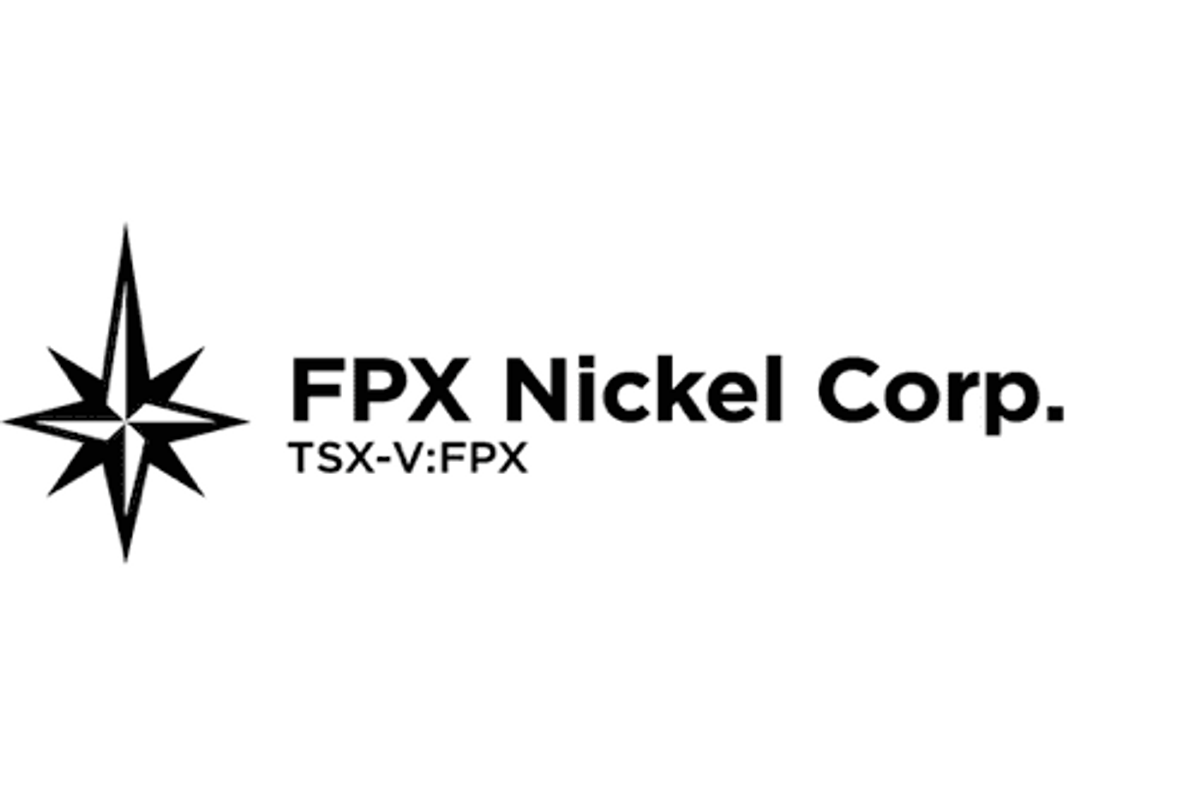
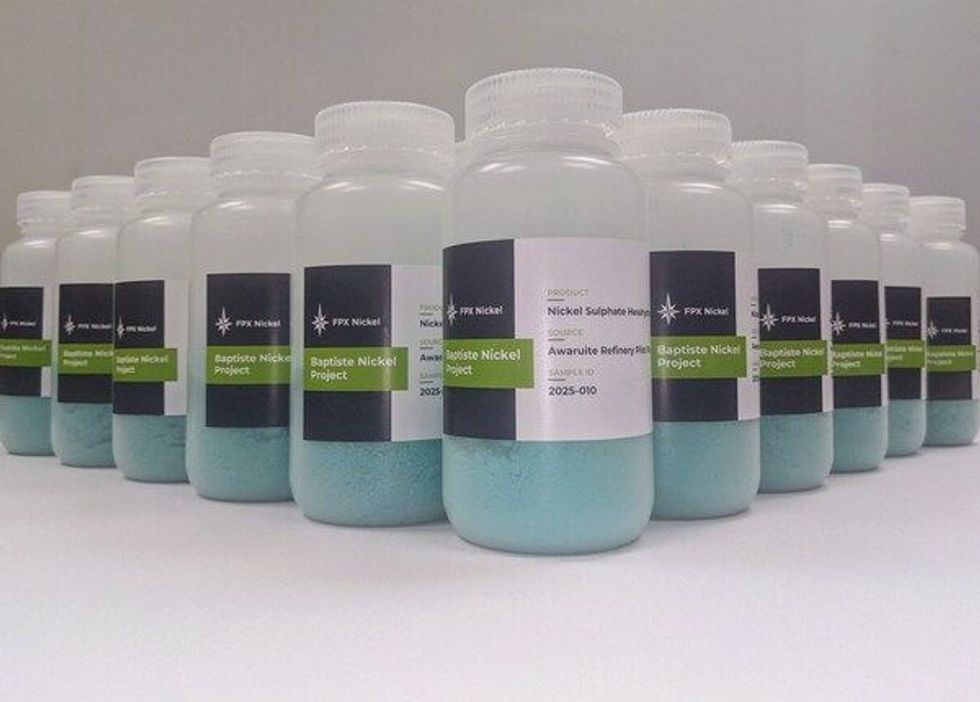
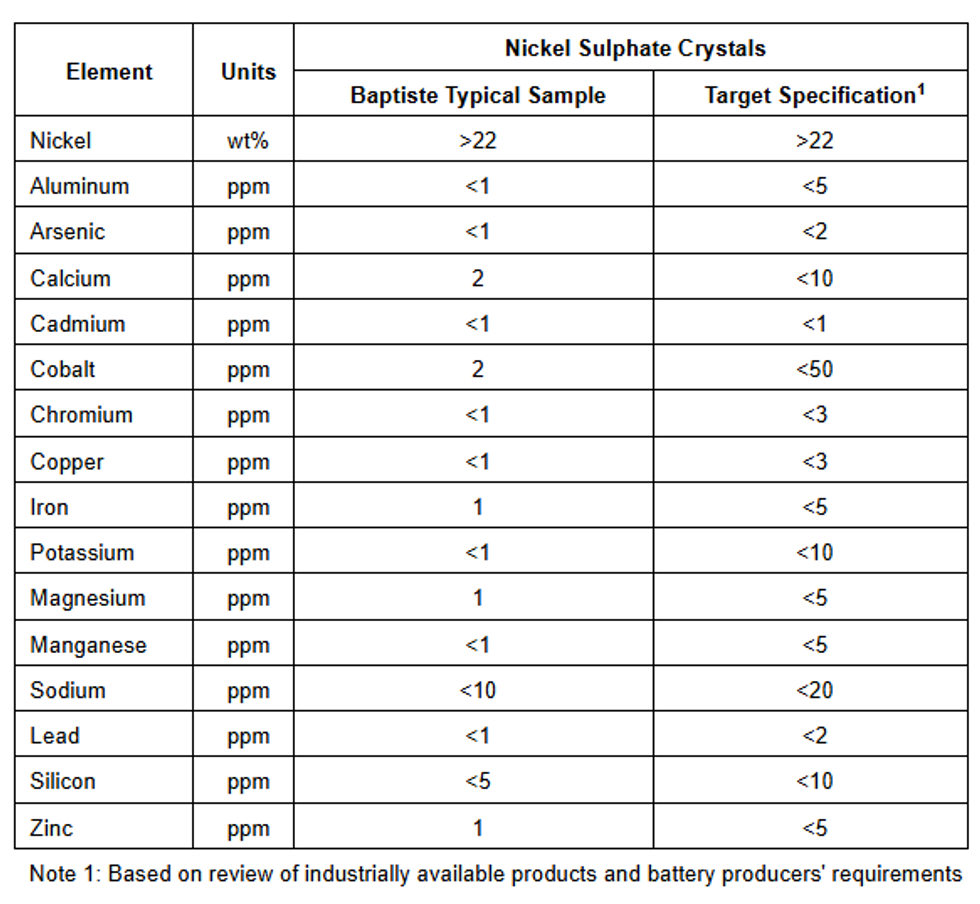 Table 2 – Baptiste Nickel Sulphate Crystal Quality vs. Target Specification
Table 2 – Baptiste Nickel Sulphate Crystal Quality vs. Target Specification